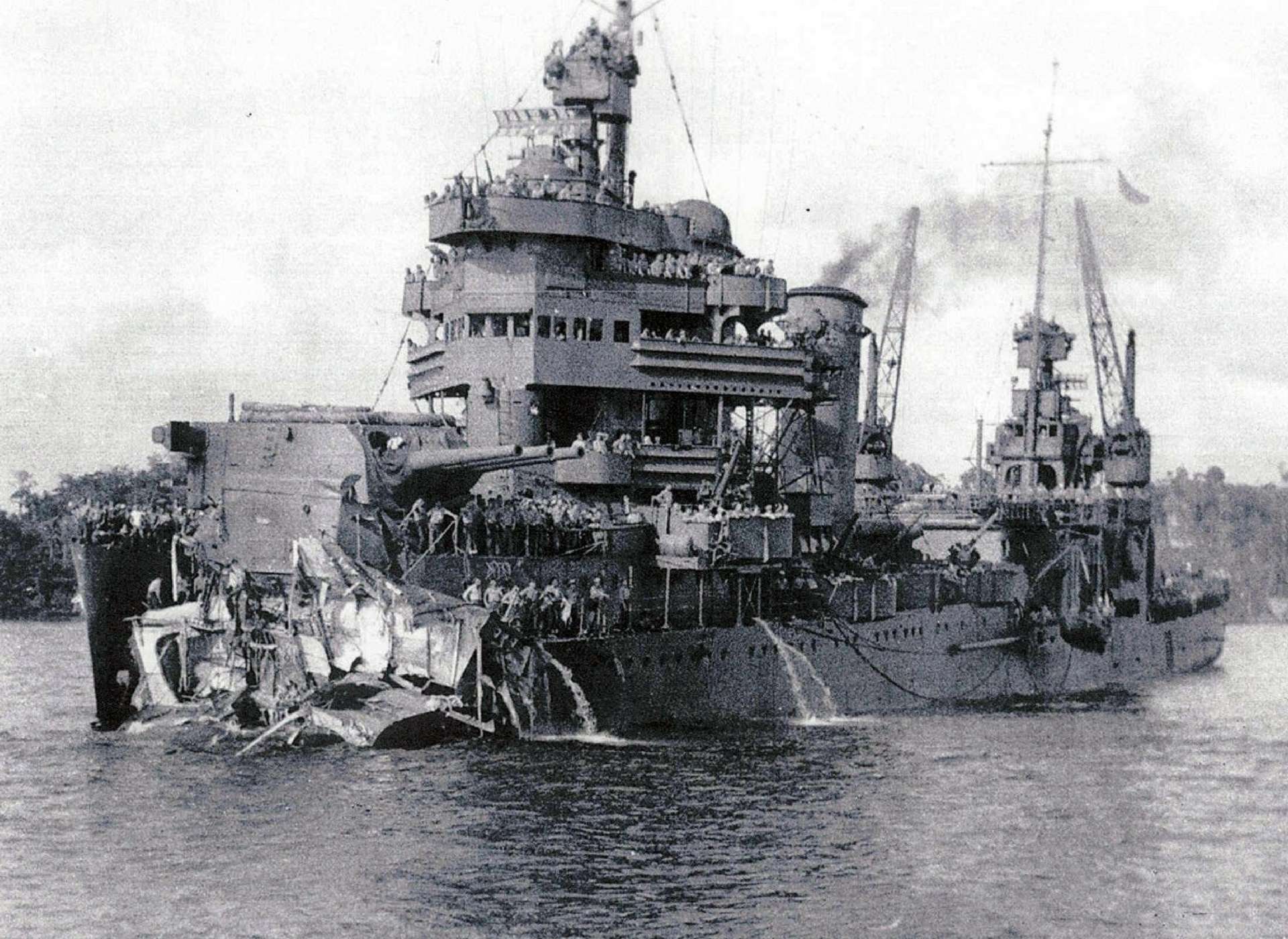I recently came across the fascinating history of the USS New Orleans (CA-32).
The New Orleans saw some of the heaviest fighting during the Pacific war, beginning on December 7, 1941, at Pearl Harbor and continuing with action at Coral Sea, Midway, Guadalcanal, and later in the Gilbert, Marshall, Marianas, Philippine, and Okinawa campaigns. It was during the Battle of Tassafaronga on November 30, 1942, off Guadalcanal that the New Orleans sustained its heaviest damage. A Japanese Type 93 “Long Lance” torpedo detonated the forward magazines and destroyed 150 feet of hull. The impact of the explosion killed 182 men. A further 50-yard length of the ship’s bow and forecastle tore away from the ship as she struggled to stay afloat.
The Damage Control Officer on the New Orleans, Lieutenant Commander Hubert M. Hayter, and two of his men, Lieutenant Richard A. Haines and Ensign Andrew L. Forman, remained at their damage control posts despite the fact that it was filling up with toxic fumes. These three brave men were eventually asphyxiated by the fumes and perished. The ship’s chaplain, Howell M. Forgy, later wrote about Hayter, “I wondered what he thought about in those final minutes, but I knew one thing: he was not afraid.”
Following the end of the battle, the New Orleans limped back to Tulagi harbor across from Guadalcanal where temporary repairs were made to try to save the ship. After working furiously for 11 days, the crew of the New Orleans managed to get the ship in a good enough condition to sail for Australia for more permanent repairs. However, due to the temporary coconut log bow, the ship had to sail backward to prevent flooding from sinking the ship.
You can read the full Navy report here.
Let’s recap, the USS New Orleans is struck by a torpedo, 183 crewmen were killed, the remaining crew put out the fire, steams it to port, patches it up with local coconut logs, then steams it backwards almost 1,200 miles across the South Pacific to safe harbor for repairs.
Seventy-eight years later the USS Bonhomme Richard burned to the keel and was lost, during peace time, docked at an American port in San Diego, because one asshole set a fire.
Now the Navy is adding two more weeks to boot camp for “more mentorship, life skills and personal and professional development.”
According to The Daily Mail:
“The Navy will add two weeks of training to its boot camp program that focusing on suicide and sexual assault prevention, hazing and extremism. It also includes the rise of extremism after several former and active military members took part in the January 6 Capitol riot.”
The last decade or so of going Woke in the military has done more damage to our Navy than all the Tojo torpedoes.


What kind of crap is this? No classes in combatting climate change and white rage? G-damn Navy. ?
“Over the years, Americans in particular have been all too willing to squander their hard-earned independence and freedom for the illusion of feeling safe under someone else’s authority. The concept of self-sufficiency has been undermined in value over a scant few generations. The vast majority of the population seems to look down their noses upon self-reliance as some quaint dusty relic, entertained only by the hyperparanoid or those hopelessly incapable of fitting into mainstream society.”
–Cody Lundin
(Dual Survivor)
They truly were the greatest generation. Everyone grew up on hard work and was alot tougher on average than young folks today.
There’s also something to be said about ship construction. I’m speculating here, but similar to how cars were made then vs now, how much can you really fix on your own anymore? Everything is very complex integrated subsystems. The Bonhomme, I suspect was victim of a cost analysis: Fix or scrap.
And I also suspect that modern ship construction takes into account that we don’t expect to get hit in an engagement. The focus is probably on capability and countermeasures. But your point is valid – we likely couldn’t or won’t do what the crew of the New Orleans did in the Pacific.
Related – how you react based on when you were born:
https://citizenfreepress.com/breaking/this-is-perfect/
I have heard that the beginning of the US car culture and availability of machinery on farms was a major advantage in WWII. In the Navy, a sailor may not have been trained in damage control — but he’d likely seen a fire extinguisher before and had some idea how to use it. In the Army we “traveled with a used car lot of vehicles” and a good percentage of the GIs knew how to do at least basic maintenance.
(I believe it was a YouTube video from Drachnifel that contrasted US and Japanese damage control. Japanese sailors were discouraged from asking questions about areas outside their specific training, and their industrialization wasn’t as far along as the US, both hurt their ability at damage control afloat.)